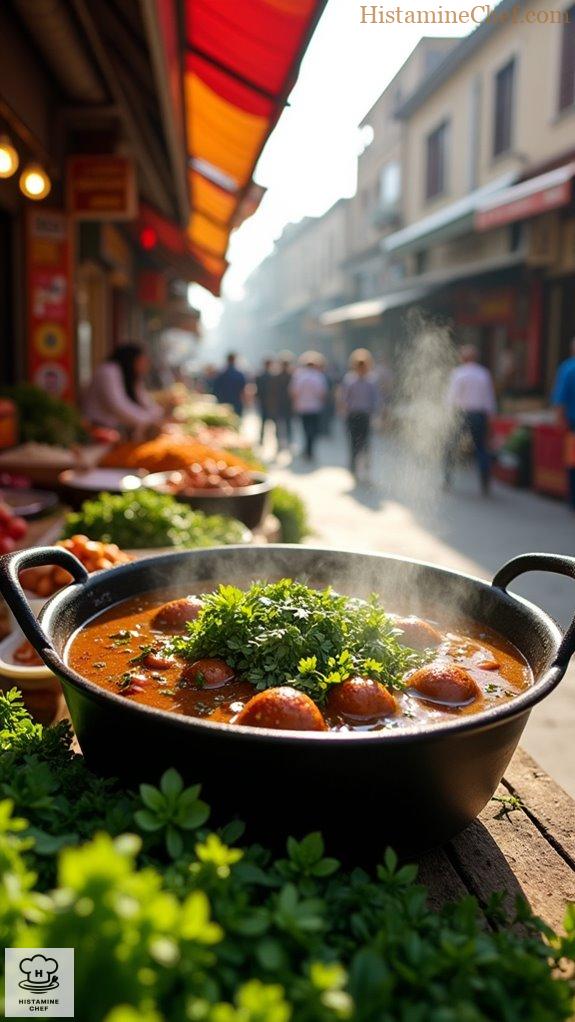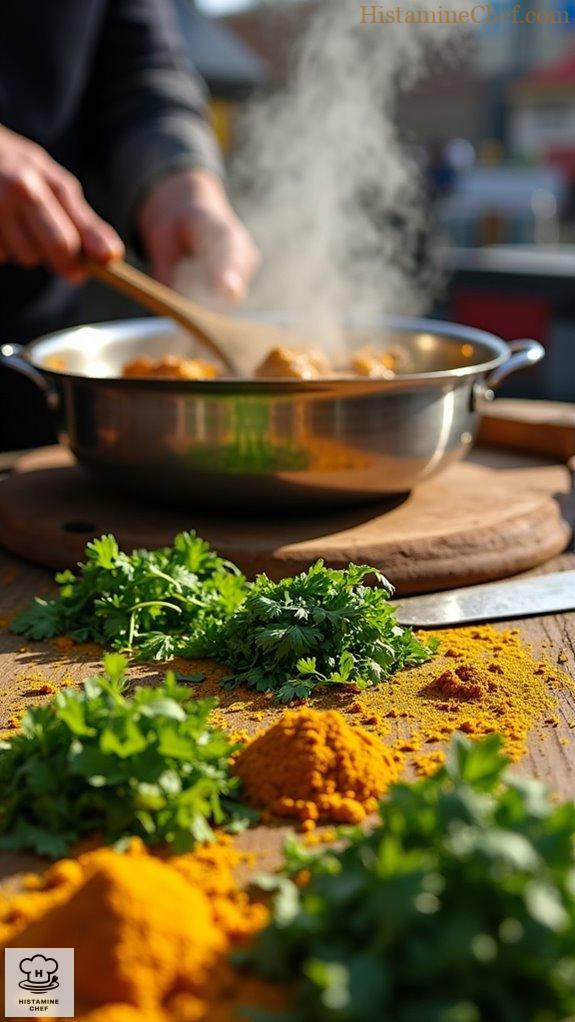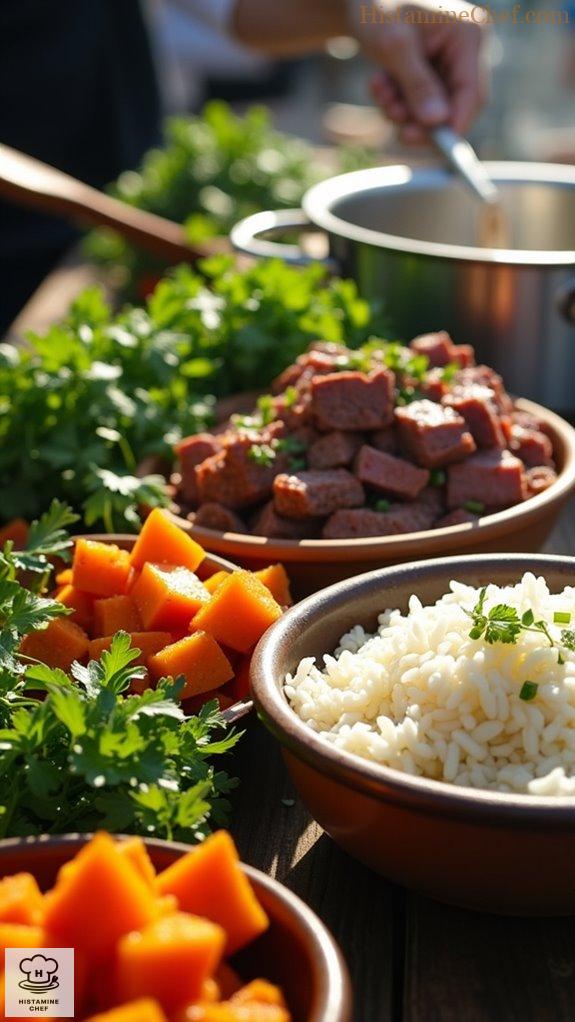Have you ever tasted Ghorme Sabzi, the national dish of Iran? It’s a flavorful stew that’s not just delicious but packed with cultural significance too. For a lower histamine twist, I use fresh chickpeas and ditch those stinky canned beans. Sauté vibrant herbs with lean beef in olive oil, simmer for hours, and serve it over fluffy basmati rice. Trust me, this dish will make your taste buds dance! Want to stir in more secrets?
Cultural Heart of Iran

Street food culture in Iran is a vibrant reflection of the country’s culinary heritage, with Ghorme Sabzi often serving as a highlight among local dishes.
Traditionally enjoyed as a home-cooked meal, this iconic herbal stew has evolved into a popular street food option in bustling markets and food stalls, particularly in cities like Tehran. The deep-rooted history of street food in Iran dates back centuries, with skilled vendors often cooking families’ favorite dishes in large pots, infusing the air with tantalizing aromas.
Ghorme Sabzi stands out due to its enticing combination of fresh herbs, tender meat, and the unique tang of dried lime, allowing passersby to experience a taste of home and tradition. This dish is particularly cherished for its cultural significance as it is considered the national dish of Iran, further enhancing its appeal among locals and visitors alike.
Street vendors pride themselves on the quality and authenticity of their preparations, echoing the labor of love typically associated with making this dish.
This evolution from a family staple to a street food favorite highlights the communal aspect of dining in Iranian society, emphasizing shared culinary experiences that foster connections within neighborhoods, further solidifying Ghorme Sabzi’s role as a symbol of hospitality and cultural pride in Iran.
Street Vendors Stir in Pots

Street vendors create the beloved meal, Street Style Ghorme Sabzi, using portable gas stoves and wide pots. They begin by heating sunflower or canola oil in the pot before adding chopped lean lamb or beef, allowing it to brown.
Fresh herbs such as parsley, leek, cilantro, and fenugreek are chopped and stirred in with wooden spoons, guaranteeing they don’t stick or burn. Water is then added to create a rich broth, and spices like turmeric are incorporated for flavor.
The stew is kept at a steady simmer, often covered, for several hours until fully cooked. Vendors maintain hygiene by frequently sanitizing hands and cleaning utensils.
Once ready, the stew is served in eco-friendly containers alongside fluffy white rice, providing an affordable and nutritious meal for urban commuters.
Ingredients Needed:
- 1 kg lean lamb or beef
- 300 g fresh parsley
- 200 g fresh leek
- 200 g fresh cilantro
- 100 g fresh fenugreek
- 100 ml sunflower or canola oil
- 2 tablespoons turmeric
- 1.5 liters water
Cooking Steps:
- Heat oil in a pot.
- Brown meat until cooked.
- Chop and add herbs.
- Stir with a wooden spoon.
- Add water and turmeric.
- Simmer for several hours.
- Serve with rice.
- Package for takeaway.
Prepare in a Slow Cooker

To prepare Street Style Ghorme Sabzi in a slow cooker, start by sautéing fresh herbs like parsley, cilantro, and chives in olive oil until fragrant.
Then, transfer them into your slow cooker along with diced beef, fresh chopped green onions, and a teaspoon of turmeric. Pour in a few cups of water and let it cook on low for 6-8 hours until the beef is tender.
Instead of using kidney beans, opt for starchy alternatives like sweet potatoes or quinoa to maintain a histamine-friendly recipe. Serve with fresh rice, ensuring it’s cooked separately to avoid high histamine content.
Changes When Cooking at Home:
- Use olive oil instead of ghee
- Omit kidney beans for sweet potatoes
- Sauté fresh herbs before adding
- Use fresh green onions, not dried
- Cook rice separately for serving
- Adjust water for desired consistency
- Cook on low heat for tenderness
Low Histamine Variation of Ghorme Sabzi

Street food often contains ingredients that are high in histamine or histamine liberators, making it difficult for individuals with histamine intolerance to safely enjoy these meals.
The combination of preserved meats, fermented components, and spices commonly found in street food can trigger reactions, leading to discomfort and health issues. Understanding the histamine content of ingredients is essential for safe consumption.
Eating street food like Ghorme Sabzi can be problematic for those with histamine intolerance due to several restricted ingredients.
On the SIGHI list, many common components such as onions, certain beans, and spices are marked as high histamine or liberators, which can exacerbate symptoms.
Furthermore, street food may not be prepared under strict hygienic conditions, increasing the risk of contamination and further complications for sensitive individuals.
Low Histamine Variation of Ghorme Sabzi Cooking Instructions:
- Replace onions with fresh herbs like parsley and coriander for flavor.
- Use fresh, not canned or dried, chickpeas for a safe legume option.
- Substitute traditional herbs with non-restricted spices like turmeric and ginger.
- Avoid adding any chilis or peppers to reduce histamine liberation.
- Use fresh and pure meat, like beef or chicken, avoiding processed types.
- Prepare using extra virgin olive oil or coconut oil as your cooking fat.
- Opt for fresh vegetables like zucchini or green beans instead of restricted ones.
- Steer clear of pickled or tinned vegetable accompaniments.
- Serve with allowed starches such as rice cooked in water.
- Garnish with low histamine herbs for an extra flavor lift.
Additionally, substituting high-histamine ingredients with vinegar alternatives can further enhance the safety of low-histamine cooking.
Video Summary
Ghorme Sabzi is a beloved Persian stew, traditionally made with herbs, meat, and kidney beans. Street vendors bring this dish to life with their vibrant flavors and aromas. In this video, we’ll explore both the authentic street version and a lower histamine home version.
Street vendors begin by sautéing finely chopped onions in a large pot until golden brown. They add pieces of tender beef, stirring until browned on all sides. Fresh herbs like parsley, cilantro, and fenugreek are chopped, filling the air with an aromatic fragrance. These herbs are added into the pot along with spices like turmeric and salt.
Next, the vendors toss in sautéed kidney beans, allowing them to mingle with the rich mix. They pour in water, bringing the stew to a boil, then simmer until thick and fragrant. The dish is typically served with fluffy basmati rice, topped with a sprinkle of sun-dried lemon for tartness.
For a lower histamine home version, substitute fresh beef with freshly frozen beef for peak freshness. Use a small amount of parsley and cilantro only instead of fenugreek. Replace kidney beans with fresh green beans or omit them altogether for a lighter touch.
Use turmeric, salt, and tailor the herbs to your tolerance, avoiding any restricted ingredients. A heavy-bottomed pot is ideal for ensuring even cooking. Keep in mind to keep the temperature stable to avoid overcooking.
Serve your creation over a bed of fluffy basmati rice. The final dish will look vibrant with a glossy finish, and it tastes earthy and hearty. Click the link in the description for the full recipe.
References
- https://wisconsinlife.org/food-traditions/wisconsin-grown-ghormeh-sabzi/
- https://www.themediterraneandish.com/ghormeh-sabzi/
- https://www.madamasr.com/en/2021/05/24/feature/lifestyle/rediscovering-iranian-food-ghormeh-sabzi/
- https://www.munchery.com/blog/persian-cooking-the-ten-iconic-dishes-of-iran/
- https://www.flooringtileworld.com/marble-tiles/ghormeh-sabzi-iran.html
- https://en.wikipedia.org/wiki/Iranian_cuisine
- https://ijdrug.com/Article/ijdrc-3050
- https://academic.oup.com/isq/article/68/3/sqae103/7721444
- https://dergipark.org.tr/en/download/article-file/366966
- https://pubmed.ncbi.nlm.nih.gov/22642243/


Leave a Reply